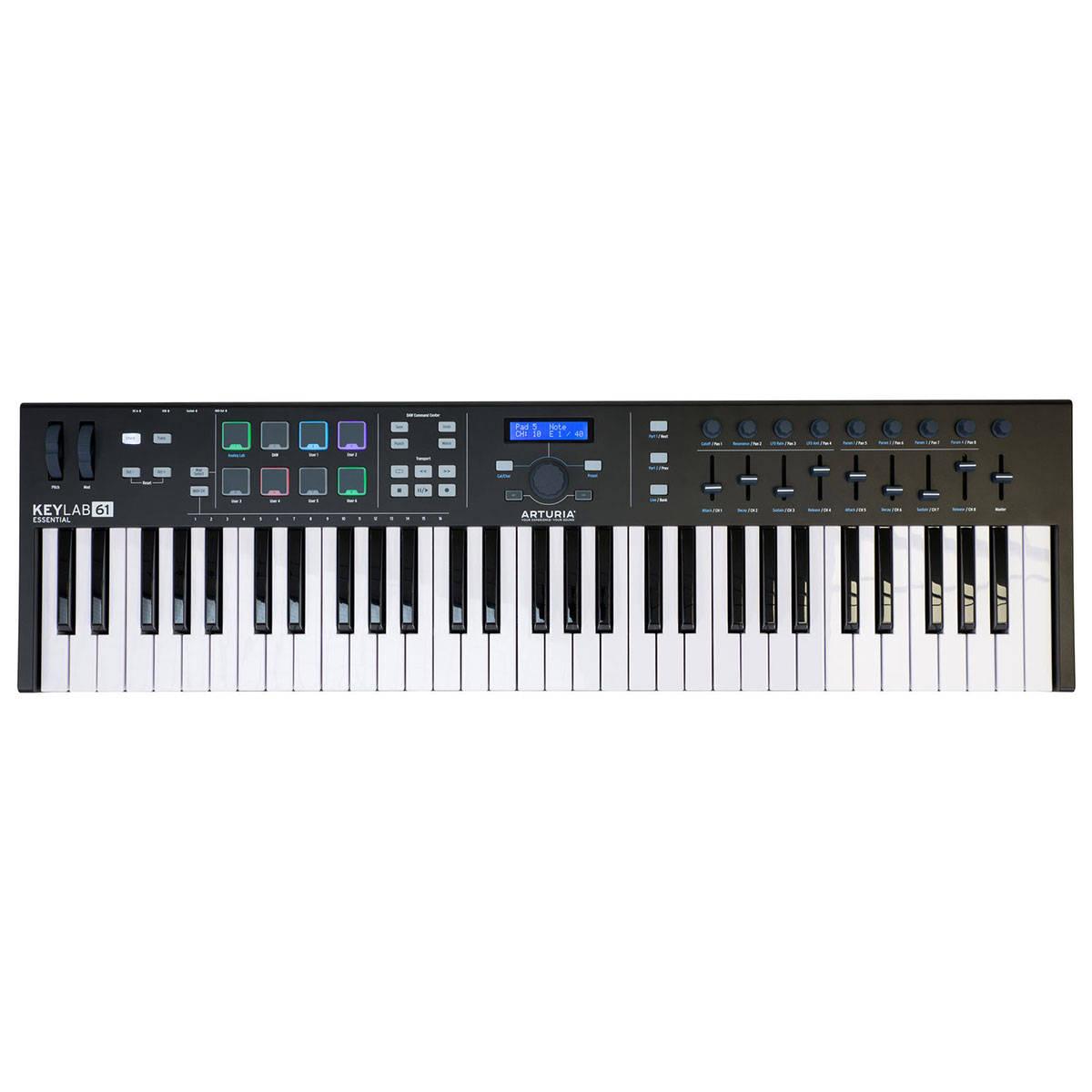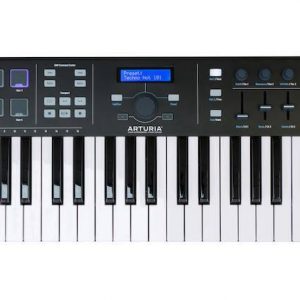Description
The Arturia Keylab Essential 61 MIDI device is an excellent instrument for musicians who are looking for a versatile and easy-to-use controller keyboard. This keyboard is the perfect solution for any musician who needs a reliable, high-quality keyboard to interface with their digital audio workstation (DAW).
The keyboard is designed with a 61-note velocity-sensitive keyboard that provides plenty of space for both playing and programming. The Semi-weighted keys have a nice feel to them and respond well to touch, making them an excellent choice for piano, keyboard and synth players.
The Keylab Essential 61 also features a plethora of controls, including 8 RGB backlit, multi-purpose pressure-sensitive pads that can be used for drum programming, sample triggering, and more. Additionally, the keyboard has a collection of 9 faders, 9 rotary knobs and 10 assignable quick-click buttons, which can be customized to work with your preferred software.
Another important feature of the Keylab Essential 61 is its compatibility with different software programs and plugins. The device comes with pre-configured mappings for most commonly used music creation software such as Ableton Live, Logic Pro X, Cubase, and Pro Tools. This means you can connect the keyboard to your workstation and start using it right out of the box.
In terms of connectivity, the keyboard has USB and MIDI ins and outs, which make it easy to connect to your computer and other MIDI-enabled devices. There’s also a sustain pedal input.
The Arturia Keylab Essential 61 is built to withstand the rigors of the road and is encased in a rugged, high-quality chassis that ensures durability and reliability. The keyboard is super lightweight and portable, making it easy to take to gigs or anywhere you want to make music.
In conclusion, the Arturia Keylab Essential 61 is an excellent MIDI keyboard that is packed with features and designed to provide maximum flexibility and control. Whether you’re a beginner looking for an easy-to-use keyboard, or a pro looking for a powerful controller, this device is an excellent choice. It’s versatile, easy to use, and built to last, making it a reliable and invaluable addition to any musician’s setup.
Arturia Keylab Essential 61 properties
| Product name | Keylab Essential 61 |
| Brand | Arturia |
| Type | Keyboard Instruments |
| Keyboard Instrument | Keyboard |
| Keys | Yes |
| Number of Keys | 61 pcs |
| Drawbars/Sliders | Yes |
| Pads | Yes |
| Rotary Controls | Yes |
| Colour | Black, White |







Mat –
A solid product, I am very satisfied with the product itself, and as a key and as a DAWA controller. ..maybe a little power-hungry for a computer, but ok .. but integration with one studio and probably other niche Dawami – a road through the torment, fortunately one YouTube tutorial shows it well, and in the end everything flashes, but there were moments that I wanted to send back with for this reason, because miracles were happening in DAWA .. and from Arturia herself, you won’t find out about it. Soft for Midi editing – known for basic matters, not necessary, but unintuitive, very weak ..
You have an Analog lab in the package – very great, uvi piano – somehow, if someone was expecting great foam like me, then no … plus great editing possibilities, I do not use the third GIFT
Valerie –
The Arturia Keylab Essential 61 is truly a masterpiece in all its 61-key glory. Wow, 61 whole keys! Who knew that was even possible?! It’s like having a whole orchestra at your fingertips, or at least a really big chunk of one. Just imagine the possibilities!
Now, let’s talk about the professional use of this extraordinary MIDI keyboard. If you’re a serious musician looking to create groundbreaking compositions, the Keylab Essential 61 is just what you need. Those 61 keys will give you the power to play with intensity and finesse, as if you were Beethoven himself. The precision and control that this keyboard provides will surely make those people from Portsmouth jealous of your musical prowess.
But don’t worry, even if you’re an amateur or just a casual music enthusiast, the Arturia Keylab Essential 61 has got you covered. The 61 keys will give you plenty of room to awkwardly press buttons and play the wrong notes, just like a true beginner would. Who needs to play the correct keys anyway? The beauty of music lies in imperfection, right?
So, whether you’re an aspiring Mozart or someone who just enjoys making noise, the Arturia Keylab Essential 61 and its 61 pcs (yes, I said pcs, because that’s how serious we are about keys) have got you covered. Go forth, my friend, and conquer the musical world with all 61 of those magnificent keys!